superior
 When I was a little girl, my family lived in Superior, Wisconsin. Those were wonderful years, but in more recent years we had not been back to Superior for a number of years. When my mom, Collene Spencer wanted to go back to Superior, my sister, Cheryl Masterson and I took her, since our dad had passed away by then. That, Ancestry, and Facebook opened up a whole new world for Cheryl and me. We got to know our cousins, and the list of cousins we know grows every day…or at least every year. This year, with the Schumacher Family Reunion, we knew we had to go, even though it would be without Mom this time. This trip was bittersweet, because of course, Mom was missing.
When I was a little girl, my family lived in Superior, Wisconsin. Those were wonderful years, but in more recent years we had not been back to Superior for a number of years. When my mom, Collene Spencer wanted to go back to Superior, my sister, Cheryl Masterson and I took her, since our dad had passed away by then. That, Ancestry, and Facebook opened up a whole new world for Cheryl and me. We got to know our cousins, and the list of cousins we know grows every day…or at least every year. This year, with the Schumacher Family Reunion, we knew we had to go, even though it would be without Mom this time. This trip was bittersweet, because of course, Mom was missing.
Nevertheless, we have had a wonderful time. When we were here the last time, our first cousins once removed, Les and Bev Schumacher had wanted us to come to their house, but our time was do limited, that we didn’t have time to. This time, their daughter, Cathy La Porte graciously invited us for dinner this evening. We got to meet her husband, Gary, as well as to see her brother, Brian Schumacher and his wife, Lisa again. It was simply a wonderful evening. Cathy is an excellent cook and we were treated to Walleye Pike and Northern Pike that Cathy’s husband, Gary caught in North Dakota with his brother this past  week. Wow!!! Was it good. Dessert was a Cherry Crumble that Lisa’s friend had given her, and everyone loved it.
week. Wow!!! Was it good. Dessert was a Cherry Crumble that Lisa’s friend had given her, and everyone loved it.
The evening was very enjoyable and will always be a sweet memory from our trip. The trip has gone by so fast, and what we thought was enough time, really wasn’t…it never is, is it? Nevertheless, the friendships (cousinships) formed will last for the rest of our lives, and while our parents weren’t there this time, we know they would be smiling…happy to see their daughters and granddaughter continue to reach out to the family as if they were with us. I guess we are carrying on the connections, and that would make them happy, and it makes me happy.
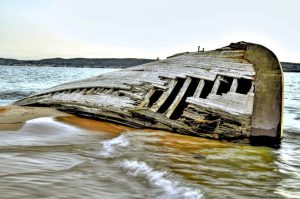 When a lake, or group of lakes, are almost the size of a small sea, with all the storm possibilities that go with a body of water the size of the sea, shipwrecks and other disasters on the water are bound to occur. There is a stretch of land along the Michigan coast, known to many as the Shipwreck Coast or the Graveyard of the Great Lakes. It is an 80 mile stretch between Grand Island and Whitefish Point, and the vicious waters have sunk hundreds of ships. Edmund Fitzgerald, Cyprus, and Vienna are just a few of the vessels lost beneath the waves, where they took their crew to a watery grave…their names forever etched in maritime lore. Their wreckages lie in varying depths of Lake Superior, the largest of the Great Lakes.
When a lake, or group of lakes, are almost the size of a small sea, with all the storm possibilities that go with a body of water the size of the sea, shipwrecks and other disasters on the water are bound to occur. There is a stretch of land along the Michigan coast, known to many as the Shipwreck Coast or the Graveyard of the Great Lakes. It is an 80 mile stretch between Grand Island and Whitefish Point, and the vicious waters have sunk hundreds of ships. Edmund Fitzgerald, Cyprus, and Vienna are just a few of the vessels lost beneath the waves, where they took their crew to a watery grave…their names forever etched in maritime lore. Their wreckages lie in varying depths of Lake Superior, the largest of the Great Lakes.
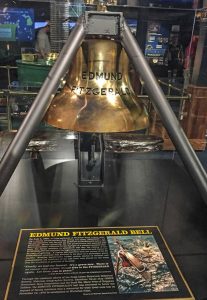 My husband, Bob and I came up for a visit in 1975, and my Uncle Bill Spencer, the original family historian, told us about the shipwrecks of Lake Superior, and how there were many that could be seen pretty clearly when flying over the lake. I wished we could have taken such a flight, and seen those ships for myself. My thoughts drifted to the time of the wrecks, and how the accident happened and about the people who lost their lives there.
My husband, Bob and I came up for a visit in 1975, and my Uncle Bill Spencer, the original family historian, told us about the shipwrecks of Lake Superior, and how there were many that could be seen pretty clearly when flying over the lake. I wished we could have taken such a flight, and seen those ships for myself. My thoughts drifted to the time of the wrecks, and how the accident happened and about the people who lost their lives there.
Lake Superior was known for its big storms, and when the November gales came it was treacherous, especially along the Shipwreck Coast. “This part of Lake Superior is particularly treacherous thanks to a unique combination of geography and storm patterns,” Bruce Lynn, executive director of the Great Lakes Shipwreck Museum in Paradise, Michigan says. “Storms build up over Canada and the Great Plains. Their strong winds blow uninterrupted over 200 miles of open waters, building up enormous waves that drive ships into the coast or break them in half.” Fog, snow squalls, smoke from forest fires, traffic jams on the busy waters and human error add to sailing hazards.
 One massive ore carrier, the Edmund Fitzgerald was the largest to sail Lake Superior, nevertheless, it was a gale or a rogue wave that caused its sinking, but what it was is debated to this day. Gordon Lightfoot immortalized the tragedy in his song “The Wreck of the Edmund Fitzgerald.” The Fitzgerald’s 200 pound bronze bell was salvaged from the bottom of the lake later on, and and restored. The men were never recovered, because as most people know, Lake Superior never gives up her dead. The ship darted out on November 7, 1975, hoping to make Whitefish Point, but that was not to be. I think that just the questions behind the shipwrecks on Lake Superior makes the thousands of shipwrecks a huge mystery.
One massive ore carrier, the Edmund Fitzgerald was the largest to sail Lake Superior, nevertheless, it was a gale or a rogue wave that caused its sinking, but what it was is debated to this day. Gordon Lightfoot immortalized the tragedy in his song “The Wreck of the Edmund Fitzgerald.” The Fitzgerald’s 200 pound bronze bell was salvaged from the bottom of the lake later on, and and restored. The men were never recovered, because as most people know, Lake Superior never gives up her dead. The ship darted out on November 7, 1975, hoping to make Whitefish Point, but that was not to be. I think that just the questions behind the shipwrecks on Lake Superior makes the thousands of shipwrecks a huge mystery.
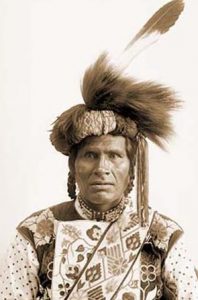 Many people think of the Indians as, well…simply the Indians, whether we intend to or not. I suppose that if we studied the different tribes, their noticeable differences would become very apparent, but if we don’t it’s not so easy to tell them apart. One of the lesser known tribes, at least early on in American history, was the Chippewa tribe. Speculation is that they were already settled in a large village at La Pointe, Wisconsin at about the time that America was discovered. Then, in the early 17th century, they abandoned this area. Many of them returning to their homeland in Sault Sainte Marie, Michigan, while others settled at the west end of Lake Superior, where they were found by Father Claude Jean Allouez, a Jesuit missionary and French explorer, in 1865.
Many people think of the Indians as, well…simply the Indians, whether we intend to or not. I suppose that if we studied the different tribes, their noticeable differences would become very apparent, but if we don’t it’s not so easy to tell them apart. One of the lesser known tribes, at least early on in American history, was the Chippewa tribe. Speculation is that they were already settled in a large village at La Pointe, Wisconsin at about the time that America was discovered. Then, in the early 17th century, they abandoned this area. Many of them returning to their homeland in Sault Sainte Marie, Michigan, while others settled at the west end of Lake Superior, where they were found by Father Claude Jean Allouez, a Jesuit missionary and French explorer, in 1865.
The Chippewa, also known as the Ojibway, Ojibwe, and Anishinaabe, are one of the largest and most powerful nations, having nearly 150 different bands located primarily in Minnesota, Wisconsin, Michigan, and southern Canada…especially Ontario, Manitoba and Saskatchewan. Ojibway means “to roast till puckered up.” It’s an odd name that referred to the puckered seam on their moccasins. Formerly, the tribe lived along both shores of Lakes Huron and Superior, extending across the Minnesota Turtle Mountains and North Dakota. They were strong in numbers and occupied an large territory, but the Chippewa were never prominent in history, mainly because of their remoteness from the frontier during the period of the colonial wars. They were part of an Algonquian group, including the Ottawa and Potawatomi, which divided when it reached Mackinaw in its westward movement.
Sault Saint Marie was their main headquarters about 1640, as mentioned by Jean Nicolet de Belleborne, a French-Canadian woodsman, who called them Baouichtigouin, meaning “people of the Sault”. In 1642, they 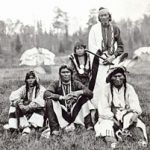 were visited by missionaries Charles Raymbaut and Isaac Jogues, who found them at the Sault and at war with a people to the west, who were probably the Sioux. Because they kept to themselves, away from the frontier, the Chippewa took a very small part in the early colonial wars, but the southern division of the tribe was known to be of warlike disposition. Those to the north of Lake Superior were considered to be peaceful. They were termed by their southern brothers as “the rabbits.” In the north, the members of the tribe were described as the “men of the thick woods” and the “swamp people,” terms used to designate the nature of the country they lived in.
were visited by missionaries Charles Raymbaut and Isaac Jogues, who found them at the Sault and at war with a people to the west, who were probably the Sioux. Because they kept to themselves, away from the frontier, the Chippewa took a very small part in the early colonial wars, but the southern division of the tribe was known to be of warlike disposition. Those to the north of Lake Superior were considered to be peaceful. They were termed by their southern brothers as “the rabbits.” In the north, the members of the tribe were described as the “men of the thick woods” and the “swamp people,” terms used to designate the nature of the country they lived in.
The Chippewa people living south of Lake Superior in the late 1600s were fishermen and hunters. They also grew corn and wild rice. Their possession of wild-rice fields was one of the chief causes of their wars with the Dakota, Fox, and other nations. At about this time, they came into possession of firearms, and began pushing their way westward, in a mixture at peace and war with the Sioux but in almost constant conflict with the Fox tribe. The French, in 1692, reestablished a trading post at Shaugawaumikong, now La Pointe Island, Wisconsin, which became an important Chippewa settlement. In the beginning of the 18th century the Chippewa succeeded in driving the Fox, already reduced by war with the French, from north Wisconsin, compelling them to take refuge with the Sac.
The Chippewa took part with the other tribes of the northwest in all the wars against the frontier settlements to  the close of the war of 1812. Those living within the United States made a treaty with the Government in 1815, and afterwards remained peaceful, residing on reservations or allotted lands within their original territory in Michigan, Wisconsin, Minnesota, and North Dakota. By 1900, the Chippewa were estimated to number about 30,000. Today, the collective bands of Chippewa or Ojibwe, are one of the largest groups of Native American People on the North American continent. There are communities in both Canada and the United States. In Canada, they are the second largest population among First Nations, surpassed only by the Cree. In the United States, they have the fourth largest population among Native American tribes, surpassed only by the Navajo, Cherokee and Lakota Sioux.
the close of the war of 1812. Those living within the United States made a treaty with the Government in 1815, and afterwards remained peaceful, residing on reservations or allotted lands within their original territory in Michigan, Wisconsin, Minnesota, and North Dakota. By 1900, the Chippewa were estimated to number about 30,000. Today, the collective bands of Chippewa or Ojibwe, are one of the largest groups of Native American People on the North American continent. There are communities in both Canada and the United States. In Canada, they are the second largest population among First Nations, surpassed only by the Cree. In the United States, they have the fourth largest population among Native American tribes, surpassed only by the Navajo, Cherokee and Lakota Sioux.
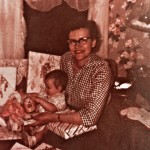 When my parents moved to Superior, Wisconsin, which is where my older sister, Cheryl Masterson and I were born, my mom was a young bride, who was experiencing the first days of marriage and the first time away from her family. I’m sure that was not really an easy time for her, but when she arrived in Superior, she was greeted by my dad’s family, who were the only people she knew there. If you have to move to a new city and state, it is nice to at least have someone that you know and can call family, as well as friend. My dad had a large family in the area with whom my mother became quite close, one of whom was my Aunt Doris Spencer, her sister-in-law, and my Uncle Bill’s wife. They spent a lot of time together, and really, had a number of “adventures” together.
When my parents moved to Superior, Wisconsin, which is where my older sister, Cheryl Masterson and I were born, my mom was a young bride, who was experiencing the first days of marriage and the first time away from her family. I’m sure that was not really an easy time for her, but when she arrived in Superior, she was greeted by my dad’s family, who were the only people she knew there. If you have to move to a new city and state, it is nice to at least have someone that you know and can call family, as well as friend. My dad had a large family in the area with whom my mother became quite close, one of whom was my Aunt Doris Spencer, her sister-in-law, and my Uncle Bill’s wife. They spent a lot of time together, and really, had a number of “adventures” together.
As young women, they were always weight conscious, and always on the latest diet. I’m sure that they thought it would be easier to diet with a buddy, and many of us have thought the same thing, but as we all know, dieting is never ease, and inevitably, they found themselves starving!! So, as a way of easing the cravings until they could eat something again, my Aunt Doris handed gave each of them one kernel of puffed wheat and said, “Here, this will tide us over until dinnertime!” Now, as we all know that would be like literally eating air, and it would not ease hunger pains in any way, but as every dieter knows, it was worth a try, because they didn’t want to mess up their diet.
 When we moved to Wyoming when I was a little over two years old, it was hard on a lot of people, but I think it was especially hard for my mom and Aunt Doris. While their “adventures” were sometimes silly and sometimes almost crazy, they always had a great time together, and they had become almost like sisters, not sisters-in-law. Aunt Doris and Uncle Bill visited us in Wyoming and we visited them in Wisconsin, but it was never quite the same. Then a few years ago, my sister, Cheryl and I took Mom to Wisconsin for a visit. it was so amazing to see the two sisters-in-law/friends together again, and I know they felt like it was an amazing reunion too. It was the last trip my Mom would make, but my Aunt Doris is still alive and going strong. Today is Aunt Doris’ 94th birthday. Happy birthday Aunt Doris!! Have a great day!! We love you!!
When we moved to Wyoming when I was a little over two years old, it was hard on a lot of people, but I think it was especially hard for my mom and Aunt Doris. While their “adventures” were sometimes silly and sometimes almost crazy, they always had a great time together, and they had become almost like sisters, not sisters-in-law. Aunt Doris and Uncle Bill visited us in Wyoming and we visited them in Wisconsin, but it was never quite the same. Then a few years ago, my sister, Cheryl and I took Mom to Wisconsin for a visit. it was so amazing to see the two sisters-in-law/friends together again, and I know they felt like it was an amazing reunion too. It was the last trip my Mom would make, but my Aunt Doris is still alive and going strong. Today is Aunt Doris’ 94th birthday. Happy birthday Aunt Doris!! Have a great day!! We love you!!
 Many years ago, anyone suffering from a communicable disease in Superior, Wisconsin, who wanted to save other family members from becoming ill could be treated at the Isolation Hospital. Superior’s twenty six room Isolation Hospital was located at 2222 East 10th Street, in Superior, Wisconsin. The hospital treated such diseases as smallpox, scarlet fever, diphtheria, and meningitis. Each of the diseases were treated in separate wards of the building, in an effort to isolate on illness from another. The hospital was managed by Mr and Mrs Peter Roe. The hospital always had a registered nurse on duty and patients could hire a private nurse as well, if needed. Mrs Roe cooked all the meals for the patients under the direction of their attending physicians. To help the patients pass the time while they were confined, “The Evening Telegram” and Superior citizens raised money for a radio. The hospital was under the supervision of Dr George Conklin. Because it was harder to cure diseases in days gone by, people might find themselves confined for some time, even the rest of their lives.
Many years ago, anyone suffering from a communicable disease in Superior, Wisconsin, who wanted to save other family members from becoming ill could be treated at the Isolation Hospital. Superior’s twenty six room Isolation Hospital was located at 2222 East 10th Street, in Superior, Wisconsin. The hospital treated such diseases as smallpox, scarlet fever, diphtheria, and meningitis. Each of the diseases were treated in separate wards of the building, in an effort to isolate on illness from another. The hospital was managed by Mr and Mrs Peter Roe. The hospital always had a registered nurse on duty and patients could hire a private nurse as well, if needed. Mrs Roe cooked all the meals for the patients under the direction of their attending physicians. To help the patients pass the time while they were confined, “The Evening Telegram” and Superior citizens raised money for a radio. The hospital was under the supervision of Dr George Conklin. Because it was harder to cure diseases in days gone by, people might find themselves confined for some time, even the rest of their lives.
Smallpox was probably the most widespread medical terror in our past. Smallpox outbreaks occurred in 1894 and 1872, and the state was swept by cholera in 1849. The same disease had decimated the troops at Fort Crawford in August 1833, taking down 23 soldiers and killing six. But the most notorious epidemic in our history was surely the Lake Superior smallpox outbreak of 1770, when the British deliberately introduced the disease among the Ojibwa Indians in revenge for the death of a fur trader. At least 300 people around modern Duluth-Superior were killed in this early act of bioterrorism. In August of 1895, smallpox had swept through the south side of Milwaukee where the traditions of recent Polish immigrants clashed with modern public health practices. The first patients were segregated at the Isolation Hospital outside the neighborhood, even though the residents preferred caring for their own sick in their own homes, as they had in the old country. When hospital patients began dying, the residents came to see it as a slaughterhouse where they would never send their loved ones. This only increased the spread of disease, of course, and soon thousands were affected. But when city health officials or ambulances attempted to remove patients to protect the uninfected, they were met by barricaded doors and armed uprisings.
Eventually Saint Mary’s Hospital replaced the Isolation Hospital. The new hospital was finished in 1911, but it 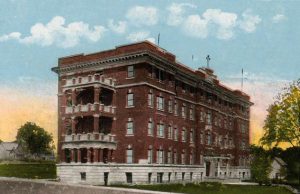 was the smallpox outbreak of May, 1915 that really put it to the test. The outbreak in Madison filled the hospitals and even took down the staff at Saint Mary’s, including the nurses and nuns. Smallpox was a terrible disease, for which there was no immunization in early years. Now with much hard work, and scientific research, it is considered a disease of the past. It also bears mentioning, that today, every time there is an outbreak of a contagious disease, doctors, nurses, staff, as well as friends and family wear protective gowns, gloves, and masks, in an effort to stop the spread of the disease. Medicine has come a long way since the days of the 1894 Smallpox epidemics. There are many ways to help people fight and win their battle against disease.
was the smallpox outbreak of May, 1915 that really put it to the test. The outbreak in Madison filled the hospitals and even took down the staff at Saint Mary’s, including the nurses and nuns. Smallpox was a terrible disease, for which there was no immunization in early years. Now with much hard work, and scientific research, it is considered a disease of the past. It also bears mentioning, that today, every time there is an outbreak of a contagious disease, doctors, nurses, staff, as well as friends and family wear protective gowns, gloves, and masks, in an effort to stop the spread of the disease. Medicine has come a long way since the days of the 1894 Smallpox epidemics. There are many ways to help people fight and win their battle against disease.
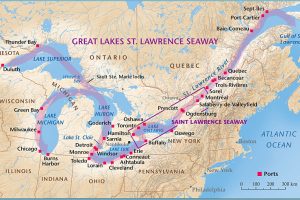 Most people know about the Great Lakes in the north-central United States, but quite possibly, many are not as familiar with the Saint Lawrence Seaway. Nevertheless, the Saint Lawrence Seaway is one of the most important parts of the Great Lakes shipping system. Prior to the Saint Lawrence Seaway there were a number of other canals. In 1871, there were locks on the Saint Lawrence River that allowed transit of vessels 186 feet long, 44 feet 6 inch wide, and 9 feet deep. The First Welland Canal, constructed from 1824–1829, had a minimum lock size of 110 feet long, 22 feet wide, and 8 feet deep, but it was generally too small to allow passage of larger ocean-going ships, which would have eliminated the majority of ships that could ship in quantity. The Welland Canal’s minimum lock size was increased to 150 feet long, 26.5 feet wide, and 9 feet deep for the Second Welland Canal, then to 270 feet long, 45 feet wide, and 14 feet deep with the Third Welland Canal, and to 766 feet long, 80 feet wide, and 30 feet deep with the fourth and current Welland Canal. Still, everyone knew that something else was going to have to be done soon.
Most people know about the Great Lakes in the north-central United States, but quite possibly, many are not as familiar with the Saint Lawrence Seaway. Nevertheless, the Saint Lawrence Seaway is one of the most important parts of the Great Lakes shipping system. Prior to the Saint Lawrence Seaway there were a number of other canals. In 1871, there were locks on the Saint Lawrence River that allowed transit of vessels 186 feet long, 44 feet 6 inch wide, and 9 feet deep. The First Welland Canal, constructed from 1824–1829, had a minimum lock size of 110 feet long, 22 feet wide, and 8 feet deep, but it was generally too small to allow passage of larger ocean-going ships, which would have eliminated the majority of ships that could ship in quantity. The Welland Canal’s minimum lock size was increased to 150 feet long, 26.5 feet wide, and 9 feet deep for the Second Welland Canal, then to 270 feet long, 45 feet wide, and 14 feet deep with the Third Welland Canal, and to 766 feet long, 80 feet wide, and 30 feet deep with the fourth and current Welland Canal. Still, everyone knew that something else was going to have to be done soon.
The first proposals for a bi-national comprehensive deep waterway along the Saint Lawrence were made in the 1890s. In the following decades, developers proposed a hydropower project that would be inseparable from the seaway,  the various governments and seaway supporters believed that the deeper water to be created by the hydro project was necessary to make the seaway channels feasible for ocean-going ships, which we all know was an essential part of the shipping business for the United States and the world. United States proposals for development up to and including World War I met with little interest from the Canadian federal government…at least at first. Later, the two national governments submitted Saint Lawrence plans to a group for study. By the early 1920s, both The Wooten-Bowden Report and the International Joint Commission recommended the project.
the various governments and seaway supporters believed that the deeper water to be created by the hydro project was necessary to make the seaway channels feasible for ocean-going ships, which we all know was an essential part of the shipping business for the United States and the world. United States proposals for development up to and including World War I met with little interest from the Canadian federal government…at least at first. Later, the two national governments submitted Saint Lawrence plans to a group for study. By the early 1920s, both The Wooten-Bowden Report and the International Joint Commission recommended the project.
The Liberal Prime Minister William Lyon Mackenzie King really wasn’t all for the project, mostly because of opposition to the project in Quebec, in 1932. He and the United States representative finally signed a treaty of intent. The treaty was submitted to the United States Senate in November of 1932 and hearings continued until a vote was taken on March 14, 1934. The majority did vote in favor of the treaty, but it failed to gain the necessary two-thirds vote for ratification. Additional attempts between the governments in the 1930s to forge an agreement Failed due to opposition by the Ontario government of Mitchell Hepburn, and that of Quebec. In 1936, John C Beukema, who was the head of the Great Lakes Harbors Association and a member of the Great Lakes Tidewater Commission, was among a delegation of eight from the Great Lakes states to meet at the White House with United States President Franklin D Roosevelt to get his support for the Seaway project.
After much back and forth wrangling, the two countries agreed that the Saint Lawrence Seaway was a  necessary addition to the Great Lakes shipping industry, and it would later prove to be a vital part of it. In the years that my sister, my parents, and I lived in Superior, Wisconsin, the Saint Lawrence Seaway was something that, at least our parents remember being under construction. The opening ceremony took place on June 26, 1959, and was presided over by United States President Dwight D Eisenhower and Queen Elizabeth II. Once it was opened, it created a navigational channel from the Atlantic Ocean to all the Great Lakes. The seaway, made up of a system of canals, locks, and dredged waterways, extends a distance of nearly 2,500 miles, from the Atlantic Ocean through the Gulf of Saint Lawrence to Duluth, Minnesota, on Lake Superior.
necessary addition to the Great Lakes shipping industry, and it would later prove to be a vital part of it. In the years that my sister, my parents, and I lived in Superior, Wisconsin, the Saint Lawrence Seaway was something that, at least our parents remember being under construction. The opening ceremony took place on June 26, 1959, and was presided over by United States President Dwight D Eisenhower and Queen Elizabeth II. Once it was opened, it created a navigational channel from the Atlantic Ocean to all the Great Lakes. The seaway, made up of a system of canals, locks, and dredged waterways, extends a distance of nearly 2,500 miles, from the Atlantic Ocean through the Gulf of Saint Lawrence to Duluth, Minnesota, on Lake Superior.
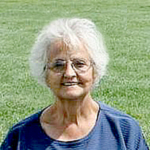 In recent years I have grown closer to my Aunt Sandy Pattan than I was in prior years. There was no particular reason we weren’t as close before, except that we were both busy. It is a poor excuse for not keeping in better contact with your aunt, and one that I’m glad has changed. It’s not that we necessarily get to see each other a whole lot more, but rather the quality of the conversations, and the visits have become much more precious to us. We have discovered a common interest in the family history, and a growing desire to get it documented for future generations, and that has solidified our…friendship really, because it is more than the typical aunt-niece relationship. When we talk, we share new discoveries that we have made, as well as the old ones, that we never seem to grow tired of hearing. We reminisce about the loved ones who have passed away, and shed some tears too, because we miss them so much, but talking about them, and even shedding the tears is what keeps their memories fresh in our hearts and minds.
In recent years I have grown closer to my Aunt Sandy Pattan than I was in prior years. There was no particular reason we weren’t as close before, except that we were both busy. It is a poor excuse for not keeping in better contact with your aunt, and one that I’m glad has changed. It’s not that we necessarily get to see each other a whole lot more, but rather the quality of the conversations, and the visits have become much more precious to us. We have discovered a common interest in the family history, and a growing desire to get it documented for future generations, and that has solidified our…friendship really, because it is more than the typical aunt-niece relationship. When we talk, we share new discoveries that we have made, as well as the old ones, that we never seem to grow tired of hearing. We reminisce about the loved ones who have passed away, and shed some tears too, because we miss them so much, but talking about them, and even shedding the tears is what keeps their memories fresh in our hearts and minds.

Aunt Sandy, being the youngest of nine children, had almost double the older siblings in some ways, because there were brothers-in-law and sisters-in-law who were a part of the family before she was a teenager, and some by the time she was two. As she said to me, “Those brothers-in-law and sisters-in-law were like my brothers and sisters, because they had been a part of the family for much of my memory.” That also gave her a unique perspective of the in-laws, because she got to see their playful side…the way they would be with her as a child. Of course, my uncles were playful with the nieces and nephews too, but it was different with her, because she was like their little sister. Those were some great times for young Aunt Sandy.
I was watching some of my parents’ old home movies last night, and there was Aunt Sandy a little girl of about 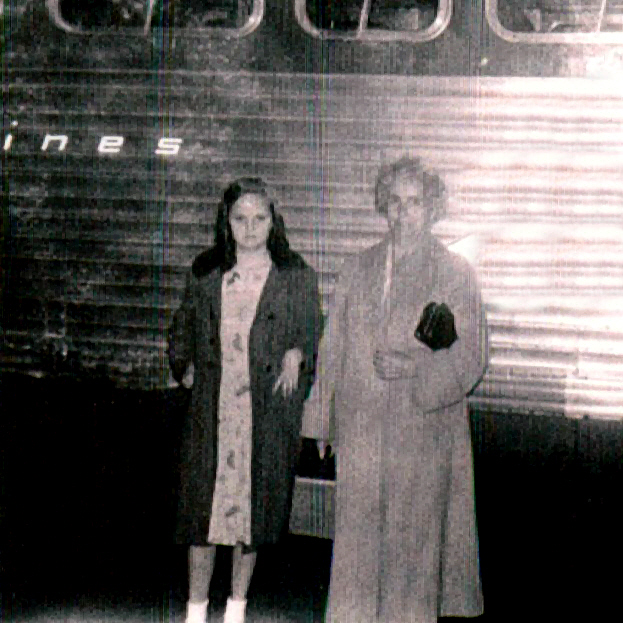 10 years. We were at a family picnic, because my parents and sister Cheryl were in Casper for a visit. They lived in Superior, Wisconsin then, and Cheryl was the only child they had then. The day was perfect, and everyone was having a great time. My parents, Allen and Collene Spencer had purchased a movie camera, and everyone was trying to decide if they wanted to be filmed or not. Most of the adults didn’t think they wanted to, but the kids were a little more open to the idea. I noticed that Aunt Sandy was having such a great time. There were more children to play with than usual for her, and everyone was having so much fun. She was literally jumping up and down with excitement. It was an awesome day for her. Today is Aunt Sandy’s birthday. Happy birthday Aunt Sandy!! Have a great day!! We love you!!
10 years. We were at a family picnic, because my parents and sister Cheryl were in Casper for a visit. They lived in Superior, Wisconsin then, and Cheryl was the only child they had then. The day was perfect, and everyone was having a great time. My parents, Allen and Collene Spencer had purchased a movie camera, and everyone was trying to decide if they wanted to be filmed or not. Most of the adults didn’t think they wanted to, but the kids were a little more open to the idea. I noticed that Aunt Sandy was having such a great time. There were more children to play with than usual for her, and everyone was having so much fun. She was literally jumping up and down with excitement. It was an awesome day for her. Today is Aunt Sandy’s birthday. Happy birthday Aunt Sandy!! Have a great day!! We love you!!
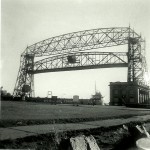 Because I was born in Superior, Wisconsin, located at the tip of Lake Superior, and across the bridge from Duluth, Minnesota, I am interested in all things that have to do with that area. My family moved to Casper, Wyoming when I was three, so I was not raised in that area, but somehow, it is in my blood. I will always have roots I can feel there. We still have a large number of family members there, and we continue to get to know them more and more due to a trip back there, and continued connections on Facebook. For that family we are very grateful, because they are all amazing.
Because I was born in Superior, Wisconsin, located at the tip of Lake Superior, and across the bridge from Duluth, Minnesota, I am interested in all things that have to do with that area. My family moved to Casper, Wyoming when I was three, so I was not raised in that area, but somehow, it is in my blood. I will always have roots I can feel there. We still have a large number of family members there, and we continue to get to know them more and more due to a trip back there, and continued connections on Facebook. For that family we are very grateful, because they are all amazing.
As I said, I love the area around Lake Superior, and the shipping business that comes through there is an amazing thing to watch. In order for shipping to thrive on Lake Superior, they had to have a way to get the big oar boats and other large ships into the port. In 1892, a contest was held to find a solution for the transportation needs to go from Minnesota Point to the other side of the canal that was dug in 1871. a man named John Low Waddell came up with the winning design for a high rise vertical lift bridge. The city of Duluth was eager to build the bridge, but the War Department didn’t like the design, and so the project was cancelled before it started. It really was an unfortunate mistake.
 Later, new plans were drawn up for a structure that would ferry people from one side to the other. This one was designed by Thomas McGilvray, a city engineer. That structure was finished in 1905. The gondola had a capacity of 60 tons and was able to carry 350 people, plus wagons, streetcars, and automobiles. The trip across took about a minutes and the ferry crossed once every five minutes, but as the population grew, the demand for a better way across grew too. They would have to rethink the situation, and amazingly, he firm finally commissioned with designing the new bridge was the descendant of Waddell’s company…the original design winner. The new design, which closely resembles the 1892 concept, is attributed to C.A.P. Turner. I guess they should have used that design in the first place, and it might have saved a lot of money.
Later, new plans were drawn up for a structure that would ferry people from one side to the other. This one was designed by Thomas McGilvray, a city engineer. That structure was finished in 1905. The gondola had a capacity of 60 tons and was able to carry 350 people, plus wagons, streetcars, and automobiles. The trip across took about a minutes and the ferry crossed once every five minutes, but as the population grew, the demand for a better way across grew too. They would have to rethink the situation, and amazingly, he firm finally commissioned with designing the new bridge was the descendant of Waddell’s company…the original design winner. The new design, which closely resembles the 1892 concept, is attributed to C.A.P. Turner. I guess they should have used that design in the first place, and it might have saved a lot of money.
Construction began in 1929. They knew that they had to be able to accommodate the tall ships that would pass through. In the new design, the roadway simply lifted in the middle, and after the ship went through it lowered  again, becoming a bridge for cars. The design is amazing, and grabs the attention of thousands of people on a regular basis. The new bridge first lifted for a vessel on March 29, 1930. Raising the bridge to its full height of 135 feet takes about a minute. The bridge is raised approximately 5,000 times per year. The bridge span is about 390 feet. As ships pass, there is a customary horn blowing sequence that is copied back. The bridge’s “horn” is actually made up of two Westinghouse Airbrake locomotive horns. Long-short-long-short means to raise the bridge, and Long-short-short is a friendly salute. The onlookers love it, and the crews often wave as well. It is like a parade of ships on a daily basis, and probably the reason that the bridge is so often the subject of pictures of the area. Happy 86th Anniversary to the Duluth Lift Bridge.
again, becoming a bridge for cars. The design is amazing, and grabs the attention of thousands of people on a regular basis. The new bridge first lifted for a vessel on March 29, 1930. Raising the bridge to its full height of 135 feet takes about a minute. The bridge is raised approximately 5,000 times per year. The bridge span is about 390 feet. As ships pass, there is a customary horn blowing sequence that is copied back. The bridge’s “horn” is actually made up of two Westinghouse Airbrake locomotive horns. Long-short-long-short means to raise the bridge, and Long-short-short is a friendly salute. The onlookers love it, and the crews often wave as well. It is like a parade of ships on a daily basis, and probably the reason that the bridge is so often the subject of pictures of the area. Happy 86th Anniversary to the Duluth Lift Bridge.
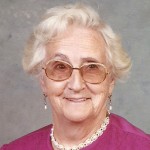 When I think of my grandmother, Harriet “Hattie” Byer, the person that comes to mind is Grandma as she was in my adult years. f course, by that time, she was a great grandmother many times over, and so had aged into the kind of grandma you always see on television…gray hair and somewhat wrinkled. In reality, it is television’s view of what a grandmother should look like that is warped in many cases…odd since they try very hard to make everyone else forever ageless. It’s not that I don’t remember the Grandma of my youth, it’s just that I really don’t think of her that way. That wasn’t what she was like as she aged, and I was at an age to place a specific memory of her in my memory files. Nevertheless, when it came to being the boss, the kidder, or the disciplinarian, all I can say is, don’t let her looks or her small stature fool you, because Grandma was in charge, and that’s all there is to it. Just ask anyone of her kids, grandkids, or
When I think of my grandmother, Harriet “Hattie” Byer, the person that comes to mind is Grandma as she was in my adult years. f course, by that time, she was a great grandmother many times over, and so had aged into the kind of grandma you always see on television…gray hair and somewhat wrinkled. In reality, it is television’s view of what a grandmother should look like that is warped in many cases…odd since they try very hard to make everyone else forever ageless. It’s not that I don’t remember the Grandma of my youth, it’s just that I really don’t think of her that way. That wasn’t what she was like as she aged, and I was at an age to place a specific memory of her in my memory files. Nevertheless, when it came to being the boss, the kidder, or the disciplinarian, all I can say is, don’t let her looks or her small stature fool you, because Grandma was in charge, and that’s all there is to it. Just ask anyone of her kids, grandkids, or 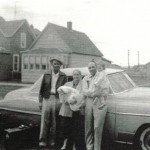 great grandkids, who might have had the misfortune of cross her. Most of us were done crossing Grandma, but there were some who were brave enough to try again…if you call that bravery. There might be a different word for it, in reality.
great grandkids, who might have had the misfortune of cross her. Most of us were done crossing Grandma, but there were some who were brave enough to try again…if you call that bravery. There might be a different word for it, in reality.
When I was little, my family lived in Superior, Wisconsin. That made it hard for her to see my sister, Cheryl Masterson and me when we were little. Grandma and Grandpa did make trips up to see us, and really loved it. Mom and Dad showed them around the area, and they spent time with us too. I don’t remember those visits, but my guess is that my sister, Cheryl does, because she was a couple of years older than I was. I love looking at the pictures of those visits with my grandparents. They are precious to me now, because of course, my parents, Grandpa, and Grandma are in Heaven now. Looking back at those moments by the lake, at the house, and on trips we took, are such wonderful memories.

We moved back to Casper before I turned three, and then we had chances to see them more often. I remember those many visits to their house so well. I can’t say I was one of those kids who learned from her mistakes, but I don’t remember very many times that I was on the wrong side of Grandma. You might call me chicken…and you would be right…either that, or smart. When Grandma spanked, it hurt. Thankfully I outgrew those days, and in the end, I remember my sweet grandma as a little old lady with gray hair. Nevertheless, she was mine, and my sisters and cousins…and we loved her. Today would have been Grandma Byer’s 107th birthday, if she were still with us. Happy birthday in Heaven, Grandma. We love and miss you very much.
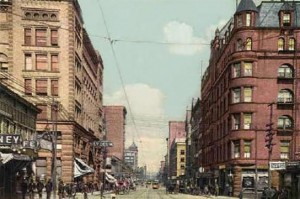 A couple of years ago, my mom, Collene Spencer, my sister, Cheryl Masterson, and I made a trip back to Superior, Wisconsin and Duluth, Minnesota to reconnect, and meet family members there. We had a wonderful trip, and both my sister and I have found sites on Facebook that display pictures of the area. Cheryl and I were both born in Superior, Wisconsin, so we feel a closeness to the area, even though we have not lived there for many years. It is still the area of our roots. Now that we have been back in a more recent time, a continue to feel drawn to the area. The strange thing is that the things I am interested in at this time, are more historic things…some of them, things that no longer exist. In my memory, we didn’t spend a lot of time in Duluth, but I’m probably mistaken on that count…at least to a degree. Superior, Wisconsin and Duluth, Minnesota are so close to each other, that if there were no signs to tell you so, you might not realize that you have left one and entered the other. I’m sure my parents shopped in Duluth, simply because as the larger of the two cities, there was quite likely more variety there.
A couple of years ago, my mom, Collene Spencer, my sister, Cheryl Masterson, and I made a trip back to Superior, Wisconsin and Duluth, Minnesota to reconnect, and meet family members there. We had a wonderful trip, and both my sister and I have found sites on Facebook that display pictures of the area. Cheryl and I were both born in Superior, Wisconsin, so we feel a closeness to the area, even though we have not lived there for many years. It is still the area of our roots. Now that we have been back in a more recent time, a continue to feel drawn to the area. The strange thing is that the things I am interested in at this time, are more historic things…some of them, things that no longer exist. In my memory, we didn’t spend a lot of time in Duluth, but I’m probably mistaken on that count…at least to a degree. Superior, Wisconsin and Duluth, Minnesota are so close to each other, that if there were no signs to tell you so, you might not realize that you have left one and entered the other. I’m sure my parents shopped in Duluth, simply because as the larger of the two cities, there was quite likely more variety there.
Recently, I started looking into some of the history of that general area, and stumbled on something 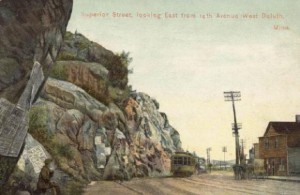 interesting. Duluth had an incline railway. Personally, I like incline railways, but I have never seen one that was in a city. Incline railways seem more like something that you would see at a tourist attractions, than anything that you would use in everyday life. Nevertheless, Duluth, in 1891, had a streetcar line, and in December 1891, the Duluth Street Railway Company opened the incline railway, as part of that street car line. The Incline Railway was on the right-of-way of Seventh Avenue West. The Duluth Street Railway Company had received a charter from the state in 1881 to build a streetcar line for Duluth. The hillside on Seventh Avenue West was too steep for a regular rail line, so they built an incline railway for that area. From it’s base station on Superior Street, the Incline climbed 509 feet in slightly more than half a mile, on a ten foot gauge track. Originally, a pair of forty one by fifteen foot cars counterbalanced each other, one going up while the other one descended. They were built to accommodate four teams and wagons, or up to 250 standing passengers. The Incline was powered by a stationary steam engine at the top. The trip took sixteen minutes, one way…just enough time to make it an enjoyable trip.
interesting. Duluth had an incline railway. Personally, I like incline railways, but I have never seen one that was in a city. Incline railways seem more like something that you would see at a tourist attractions, than anything that you would use in everyday life. Nevertheless, Duluth, in 1891, had a streetcar line, and in December 1891, the Duluth Street Railway Company opened the incline railway, as part of that street car line. The Incline Railway was on the right-of-way of Seventh Avenue West. The Duluth Street Railway Company had received a charter from the state in 1881 to build a streetcar line for Duluth. The hillside on Seventh Avenue West was too steep for a regular rail line, so they built an incline railway for that area. From it’s base station on Superior Street, the Incline climbed 509 feet in slightly more than half a mile, on a ten foot gauge track. Originally, a pair of forty one by fifteen foot cars counterbalanced each other, one going up while the other one descended. They were built to accommodate four teams and wagons, or up to 250 standing passengers. The Incline was powered by a stationary steam engine at the top. The trip took sixteen minutes, one way…just enough time to make it an enjoyable trip.
In 1925, it was noted that the Incline carried an average of 2,170 weekday passengers, while the connecting 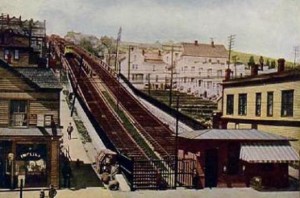 Highland streetcar line carried an average of only 1,114 weekday passengers. I’m sure that was because people like incline railways…they are unique….besides, climbing that hill would not be fun. Hourly checks showed that most riders traveled downhill in the morning rush hour and uphill during the afternoon rush hour. Most likely they were commuting to and from work. The Duluth Incline Railway was never profitable. Nevertheless, it and the Highland line were the last remnants of the streetcar system to be replaced by buses. Their last day of service was September 4, 1939. For that reason, I’m sure that many of the current residents of Duluth don’t even know about the incline railroad. I didn’t either, until I stumbled on it.
Highland streetcar line carried an average of only 1,114 weekday passengers. I’m sure that was because people like incline railways…they are unique….besides, climbing that hill would not be fun. Hourly checks showed that most riders traveled downhill in the morning rush hour and uphill during the afternoon rush hour. Most likely they were commuting to and from work. The Duluth Incline Railway was never profitable. Nevertheless, it and the Highland line were the last remnants of the streetcar system to be replaced by buses. Their last day of service was September 4, 1939. For that reason, I’m sure that many of the current residents of Duluth don’t even know about the incline railroad. I didn’t either, until I stumbled on it.

